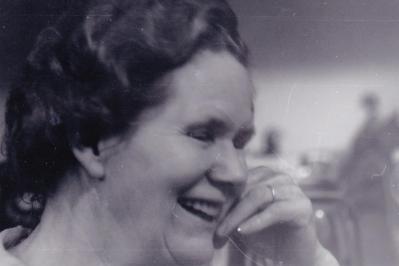
My Oma made the best bread. Nobody that I know of in my family ever learned quite how to make her bread the way she did. I’ve tried a number of times to recreate it, including baking it in a brick oven once like she did sometimes. This is the closest I’ve ever gotten to making bread that tastes like hers, and I think the potato water is a big part of that. Also the method of baking it in a lidded dish helps to create that nice dark crust.
This is a version of the popular no-knead bread making method. I added the potato water to make it more like Oma’s bread. No-knead bread is super easy to make, and so delicious. Now that my favourite local bread bakery (Terra Breads) has closed due to the pandemic, I’m making this bread regularly.
The potato water adds some flavour and gives the bread a nice texture. To make potato water you can boil some potatoes ahead of time for another meal, then save the cooking water in the fridge until you want to make this bread. Just bring the potato water to room temperature before mixing the dough.
I used a lidded baking dish for this, my le Creuset French oven. At other times I’ve used a Romertopf baker. I imagine a casserole dish with a lid could work too. You could bake it without a lid too, which I haven’t done with this recipe yet.
What you need:
- 3/4 cup dark rye flour
- 2 & 1/4 cups white flour
- 1 & 1/4 teaspoons salt
- 1/4 teaspoon yeast
- 1 & 1/2 cups room temperature potato water
What you do:
- Combine the flours, salt and yeast in a large bowl. Add the potato water and mix it up. You will end up with a shaggy, sticky dough.
- Cover the bowl with plastic wrap or a lid, and let sit for 12-18 hours in a warm-ish place, and out of direct sunlight. The dough should about double in size and become dotted with bubbles. If your house is a little on the cool side you will likely need the longer rising time.
- Cut a large piece of parchment paper and place it on a countertop. Coat the parchment paper with a bit of oil using your hands, then turn the dough out onto the parchment paper. Sprinkle the surface of the dough with flour. Cover the dough loosely with some plastic wrap or a kitchen towel. Let the dough sit for 1-2 hours, until it has doubled in volume.
- About 1/2 an hour before you want to put the bread in the oven, set the temperature to 475°F and place your baking pot on a rack in the lower third of the oven. Let the pot heat up, and when the oven has reached 475°F, remove the pot from the oven. Pick up the dough by gathering together the corners of the parchment paper. Carefully (remember the pot is smoking hot!) place the dough (still on the parchment paper) into the pot. I cut away any really long bits of parchment that are sticking out of the pot.
- Put the cover on the pot and bake for 30 minutes while the bread forms its nice thick crust. Remove the lid from the pot and continue to bake for 15-20 minutes more. The bread should become a deep brown when it is done, and if you tap on it, it should sound hollow. Remove the pot from the oven, lift the bread out of the pot, remove the parchment paper, and place it on a rack to cool. It needs to cool for about 1/2 an hour before slicing.
- This bread has no preservatives, so if you don’t use it up by the second day, it should be refrigerated frozen.





